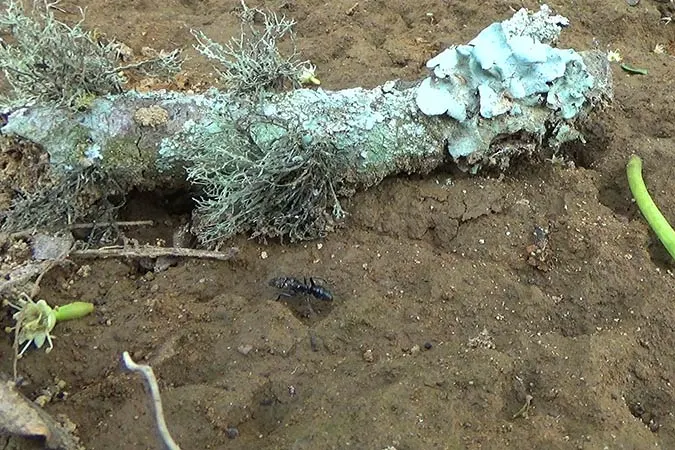Semut godam or godam ant (Odontoponera denticulata) is animal species in Formicidae, black ants, mandibular shaped triangular, antenal scrobe and antenal socket hanging on the mandible, living on the edge of tropical rain forests, plantations and disturbed lands.
O. denticulata has a tanned black body, a rough body with striped striated, antennas consisting of 12-13 segments, anterior clypeus has 7-9 teeth, pronotum shaped triangular, petiol rounded up and claws on the hind legs do not have spines.
The eyes are relatively large compared to species in the same genus, the mandible has four large teeth with a smaller bottom, ocelli is small and triangular in shape and clypeus has thin hair.
The queen has a length of 11-13 mm and has wings. Workers have a length of 9-12 mm. Short, triangular and massive mandible with basal grooves. The eye is relatively small and sits anteriorly from the center of the head with a smooth preocular carina. Pronotum with short spine in each anterodorsal angle.
Metanotal groove is very shallow or reduced to a simple stitch. Propodeum narrows back, posterior margins with a shallow denticulate back. Propodeal spiroid ovoid. Squamiform petiole with sharp denticulate and dorsal margin emarginate.
Gaster with narrowing of the belt between pre and post-sclerite. The head and mesosoma are very striated with mild convoluted gasters. Head and body with scattered pilosity and only mild puberty.
Godam ants inhabit wood habitats including forest edges and disturbed areas, nest on the ground and forage on the surface. A colony occupies several different nests connected by underground tunnels with many entrances. Workers effectively guard the nest entrance from looters.
Workers are mostly epigeic gatherers and common predators who often invade termite colonies and other ants. Hunting and foraging within a distance of about one meter from the entrance of the prey nest. The mandible gland and stomach secretions have protein as poisons.
Kingdom: Animalia
Phylum: Arthropoda
Subphylum: Hexapoda
Class: Insecta
Subclass: Pterygota
Order: Hymenoptera
Suborder: Apocrita
Infraorder: Aculeata
Superfamily: Vespoidea
Family: Formicidae
Subfamily: Ponerinae
Tribe: Ponerini
Genus: Odontoponera
Species: Odontoponera denticulata
O. denticulata has a tanned black body, a rough body with striped striated, antennas consisting of 12-13 segments, anterior clypeus has 7-9 teeth, pronotum shaped triangular, petiol rounded up and claws on the hind legs do not have spines.
The eyes are relatively large compared to species in the same genus, the mandible has four large teeth with a smaller bottom, ocelli is small and triangular in shape and clypeus has thin hair.
The queen has a length of 11-13 mm and has wings. Workers have a length of 9-12 mm. Short, triangular and massive mandible with basal grooves. The eye is relatively small and sits anteriorly from the center of the head with a smooth preocular carina. Pronotum with short spine in each anterodorsal angle.
Metanotal groove is very shallow or reduced to a simple stitch. Propodeum narrows back, posterior margins with a shallow denticulate back. Propodeal spiroid ovoid. Squamiform petiole with sharp denticulate and dorsal margin emarginate.
Gaster with narrowing of the belt between pre and post-sclerite. The head and mesosoma are very striated with mild convoluted gasters. Head and body with scattered pilosity and only mild puberty.
Godam ants inhabit wood habitats including forest edges and disturbed areas, nest on the ground and forage on the surface. A colony occupies several different nests connected by underground tunnels with many entrances. Workers effectively guard the nest entrance from looters.
Workers are mostly epigeic gatherers and common predators who often invade termite colonies and other ants. Hunting and foraging within a distance of about one meter from the entrance of the prey nest. The mandible gland and stomach secretions have protein as poisons.
Kingdom: Animalia
Phylum: Arthropoda
Subphylum: Hexapoda
Class: Insecta
Subclass: Pterygota
Order: Hymenoptera
Suborder: Apocrita
Infraorder: Aculeata
Superfamily: Vespoidea
Family: Formicidae
Subfamily: Ponerinae
Tribe: Ponerini
Genus: Odontoponera
Species: Odontoponera denticulata
